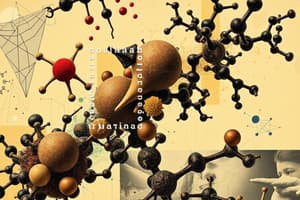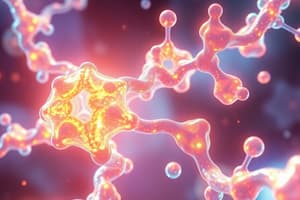Podcast
Questions and Answers
What is a monomer?
What is a monomer?
- A type of carbohydrate
- Repeating units of a polymer (correct)
- A long molecule made of similar building blocks
- A reaction involving water
What defines a polymer?
What defines a polymer?
- A protein structure
- A long molecule made of similar building blocks linked by covalent bonds (correct)
- A single sugar molecule
- A type of amino acid
What is dehydration (condensation reaction)?
What is dehydration (condensation reaction)?
- A type of sugar
- A protein formation process
- The addition of water to separate monomers
- Monomers connect by two molecules bonding and losing water (correct)
What is hydrolysis?
What is hydrolysis?
What are monosaccharides?
What are monosaccharides?
What are disaccharides?
What are disaccharides?
What characterizes polysaccharides?
What characterizes polysaccharides?
Describe starch.
Describe starch.
What is glycogen?
What is glycogen?
What is cellulose?
What is cellulose?
What is chitin?
What is chitin?
What is the difference between alpha glucose and beta glucose?
What is the difference between alpha glucose and beta glucose?
Describe the structure of a fat (triglyceride).
Describe the structure of a fat (triglyceride).
What is the difference between saturated and unsaturated fatty acids?
What is the difference between saturated and unsaturated fatty acids?
Describe the structure of a phospholipid.
Describe the structure of a phospholipid.
What is a steroid?
What is a steroid?
What is the structure of an amino acid?
What is the structure of an amino acid?
What is a polypeptide?
What is a polypeptide?
What kind of bonds hold amino acids together?
What kind of bonds hold amino acids together?
What is primary structure in proteins?
What is primary structure in proteins?
What is secondary structure in proteins?
What is secondary structure in proteins?
What is tertiary structure in proteins?
What is tertiary structure in proteins?
What is quaternary structure in proteins?
What is quaternary structure in proteins?
What are different R groups in amino acids?
What are different R groups in amino acids?
Describe the structure and function of DNA.
Describe the structure and function of DNA.
What is a nucleic acid?
What is a nucleic acid?
What are nucleotides?
What are nucleotides?
What is the structure and function of RNA?
What is the structure and function of RNA?
What is the difference between pyrimidine and purine?
What is the difference between pyrimidine and purine?
Flashcards
Monomers
Monomers
Repetitive units that make up polymers.
Polymers
Polymers
Long molecules formed by linking monomers.
Dehydration Reaction
Dehydration Reaction
Bonding two monomers with water release.
Hydrolysis
Hydrolysis
Signup and view all the flashcards
Monosaccharides
Monosaccharides
Signup and view all the flashcards
Disaccharides
Disaccharides
Signup and view all the flashcards
Polysaccharides
Polysaccharides
Signup and view all the flashcards
Starch
Starch
Signup and view all the flashcards
Glycogen
Glycogen
Signup and view all the flashcards
Cellulose
Cellulose
Signup and view all the flashcards
Chitin
Chitin
Signup and view all the flashcards
Alpha Glucose
Alpha Glucose
Signup and view all the flashcards
Beta Glucose
Beta Glucose
Signup and view all the flashcards
Triglycerides
Triglycerides
Signup and view all the flashcards
Saturated Fatty Acids
Saturated Fatty Acids
Signup and view all the flashcards
Unsaturated Fatty Acids
Unsaturated Fatty Acids
Signup and view all the flashcards
Phospholipids
Phospholipids
Signup and view all the flashcards
Steroids
Steroids
Signup and view all the flashcards
Amino Acids
Amino Acids
Signup and view all the flashcards
Polypeptides
Polypeptides
Signup and view all the flashcards
Peptide Bonds
Peptide Bonds
Signup and view all the flashcards
Primary Protein Structure
Primary Protein Structure
Signup and view all the flashcards
Secondary Protein Structure
Secondary Protein Structure
Signup and view all the flashcards
Tertiary Protein Structure
Tertiary Protein Structure
Signup and view all the flashcards
Quaternary Protein Structure
Quaternary Protein Structure
Signup and view all the flashcards
DNA Structure
DNA Structure
Signup and view all the flashcards
Nucleotides
Nucleotides
Signup and view all the flashcards
RNA Structure
RNA Structure
Signup and view all the flashcards
Pyrimidines
Pyrimidines
Signup and view all the flashcards
Purines
Purines
Signup and view all the flashcards
Study Notes
Key Concepts in Biochemistry
- Monomers are the repeating units that serve as building blocks for larger structures, known as polymers.
- Polymers are long molecules formed by linking similar building blocks via covalent bonds.
Reactions Involving Monomers
- Dehydration (Condensation) Reaction: This process involves the bonding of two monomers, resulting in the release of a water molecule.
- Hydrolysis: In this reaction, a water molecule is added to separate two monomers, breaking down polymers into their monomer components.
Sugars and Their Structures
- Monosaccharides are simple sugars with a carbonyl group (C=O) and hydroxyl groups (-OH); they can range from 3 to 7 carbons. Examples include glucose, fructose, and ribose.
- Disaccharides consist of two monosaccharides linked by glycosidic linkages through dehydration. Common examples are sucrose, lactose, and maltose.
- Polysaccharides are macromolecules formed from hundreds to thousands of monosaccharides joined by glycosidic linkages, serving various functions like storage or structural material. Key examples include starch, cellulose, and glycogen.
Specific Polysaccharides
- Starch: A plant polysaccharide composed of α-glucose monomers, stored in plastids; it allows plants to stockpile surplus sugars, later accessible via hydrolysis.
- Glycogen: A polymer of glucose stored in the liver and muscle cells of vertebrates; it can be quickly mobilized through hydrolysis when energy needs increase.
- Cellulose: A structural component of cell walls, this β-glucose polymer is the most abundant organic compound on Earth; most animals cannot digest it due to its β linkages.
- Chitin: A structural polysaccharide in arthropod exoskeletons, comprising interwoven strands providing strength and flexibility.
Structural Variations of Glucose
- Alpha vs. Beta Glucose: The hydroxyl group's position varies; in alpha glucose, it faces down, while in beta glucose, it is positioned above the ring on the first carbon. They are isomers, sharing the same molecular formula.
Lipids and Their Structures
- Triglycerides (Fats): Comprise a glycerol head bonded to three fatty acid tails through ester bonds, formed via dehydration synthesis.
- Saturated Fatty Acids: Fully saturated with hydrogen atoms, lacking double bonds, while unsaturated fatty acids contain one or more double bonds, resulting in a kinked structure.
- Phospholipids: Consist of two fatty acid tails and a negatively charged phosphate head. They are crucial for forming cell membranes.
- Steroids: A class of lipids characterized by a carbon skeleton with four fused rings; examples include cholesterol, sex hormones, and vitamin D.
Proteins and Their Structures
- Amino Acids: Basic building blocks, characterized by a carboxyl group (COOH) and an amino group (NH2).
- Polypeptides: Chains of amino acids linked by peptide bonds, formed through dehydration reactions.
- Peptide Bonds: Specialized covalent bonds that connect amino acids in a polypeptide.
- Protein Structures:
- Primary Structure: Sequence of amino acids linked by peptide bonds.
- Secondary Structure: Formed by hydrogen bonds between backbone atoms, resulting in alpha helices or beta sheets.
- Tertiary Structure: The overall 3D shape driven by interactions among R groups, including hydrophobic interactions, hydrogen bonds, ionic bonds, and disulfide bridges.
- Quaternary Structure: The assembly of two or more polypeptide chains into a functional protein.
Nucleic Acids
- DNA Structure: Composed of nucleotides bonded by phosphodiester bonds, with specific complementary base pairing (G with C, T with A).
- Nucleotides: Each contains a phosphate group, a pentose sugar, and a nitrogenous base.
- RNA Structure: Similar to DNA but single-stranded and contains uracil instead of thymine, playing a key role in information transport.
Nitrogenous Bases
- Pyrimidines: Single six-membered rings of carbon and nitrogen; include cytosine, uracil, and thymine.
- Purines: Larger structures comprising fused six-membered and five-membered rings; include adenine and guanine.
Studying That Suits You
Use AI to generate personalized quizzes and flashcards to suit your learning preferences.




